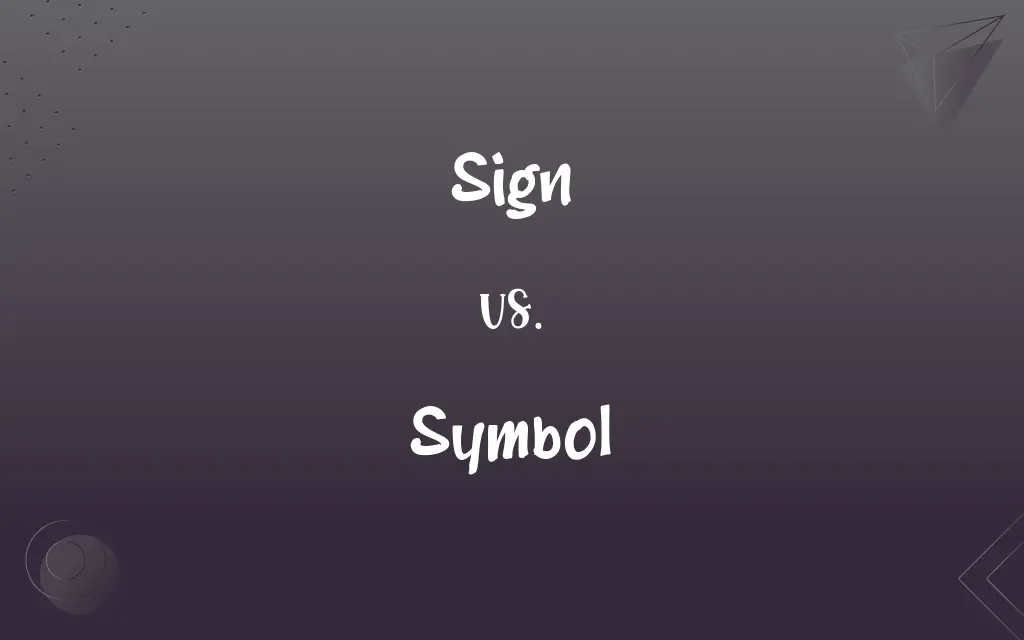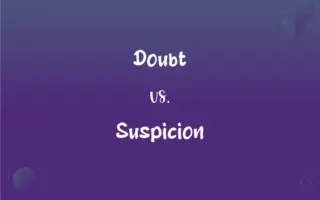Sign vs. Symbol: What's the Difference?
Edited by Aimie Carlson || By Janet White || Published on December 29, 2023
A sign is a direct representation or indication, often literal, while a symbol carries deeper, often abstract meanings.

Key Differences
A sign directly represents an object, action, or idea, being often literal and straightforward. In contrast, a symbol is more abstract, representing something beyond its literal meaning, often carrying cultural or emotional significance.
Signs are typically used for conveying specific information or instructions, like road signs indicating directions. Symbols, however, embody broader concepts or ideas, like a dove symbolizing peace.
In language, signs can be words or phrases that directly communicate an idea. Symbols, on the other hand, are used to evoke thoughts or feelings, like in literature where a storm may symbolize turmoil.
Signs often require less cultural or contextual understanding, being more universally understood. Symbols can vary in interpretation based on cultural or personal contexts.
The effectiveness of a sign lies in its clarity and directness, whereas a symbol’s power is in its ability to convey complex ideas and emotions through association.
ADVERTISEMENT
Comparison Chart
Literal Meaning
Represents directly
Represents abstractly
Function
Conveys information
Conveys ideas or concepts
Interpretation
Generally universal
Subject to context
Usage in Language
Direct communication
Evokes deeper meanings
Cultural Dependence
Less culturally dependent
Heavily influenced by culture
ADVERTISEMENT
Sign and Symbol Definitions
Sign
A sign is a physical indication.
The stop sign on the road indicates drivers must halt.
Symbol
A symbol is an object representing an idea, quality, or concept.
A heart symbol represents love.
Sign
A sign can be an omen or indication of something.
Dark clouds are a sign of impending rain.
Symbol
A symbol can be a representative emblem.
The eagle is a symbol of freedom in many cultures.
Sign
A sign can be a gesture used to convey information.
A thumbs-up sign indicates approval.
Symbol
A symbol can be a character representing an action or process.
In mathematics, '+' is a symbol for addition.
Sign
A sign is a posted notice conveying information.
The sign outside the park displayed its closing hours.
Symbol
In literature, a symbol is a motif with deeper meaning.
The river in the story symbolizes life's journey.
Sign
In linguistics, a sign is a word that denotes a specific object or concept.
The word tree is a sign for the actual plant.
Symbol
In religion, a symbol is an icon with spiritual significance.
The cross is a powerful symbol in Christianity.
Sign
Something that suggests the presence or existence of a fact, condition, or quality
A high temperature is a sign of fever.
Symbol
Something that represents something else by association, resemblance, or convention, especially a material object used to represent something invisible
The lamb is a symbol of innocence.
FAQs
Are signs culturally specific?
While some signs are universal, others can have specific meanings in different cultures.
Is a logo a sign or a symbol?
A logo can be both, depending on its design and the ideas it represents.
Can symbols change meaning over time?
Yes, the meanings of symbols can evolve with cultural and societal changes.
What defines a sign in linguistics?
In linguistics, a sign is a basic unit of meaning, like a word or phrase.
Is a traffic light a sign or a symbol?
It's a sign, as it conveys specific, direct instructions.
What is a symbol in literature?
In literature, a symbol is an element that represents larger ideas or themes.
Can a sign be a natural occurrence?
Yes, natural occurrences like a red sky can serve as signs, often as omens or indicators.
Can signs exist in non-verbal forms?
Yes, signs can be non-verbal, like hand gestures or facial expressions.
Can a person be a symbol?
Yes, individuals can symbolize broader ideas or movements.
Can a flag be a symbol?
Yes, a flag is a symbol representing a country or organization.
Do signs convey more direct information than symbols?
Yes, signs are generally more direct and specific than symbols.
Is color usage in art a form of symbolism?
Yes, colors in art can be used symbolically to convey emotions or themes.
Are symbols always intentional?
Symbols can be both intentional and unintentional, depending on the context.
Can a sign also be a symbol?
In some contexts, a sign can also function as a symbol, carrying deeper meanings.
Is an emoji a sign or a symbol?
An emoji can be both, depending on its usage and the context.
Are religious icons considered symbols?
Yes, religious icons are symbols with spiritual significance.
Can animals be symbols in literature?
Yes, animals are often used as symbols to represent human traits or ideas.
Do symbols require interpretation?
Yes, symbols often require interpretation and can have multiple meanings.
Are mathematical notations considered signs?
Yes, they are signs representing specific operations or values.
Is symbolism subjective?
Symbolism can be subjective, as different people may interpret symbols differently.
About Author
Written by
Janet WhiteJanet White has been an esteemed writer and blogger for Difference Wiki. Holding a Master's degree in Science and Medical Journalism from the prestigious Boston University, she has consistently demonstrated her expertise and passion for her field. When she's not immersed in her work, Janet relishes her time exercising, delving into a good book, and cherishing moments with friends and family.
Edited by
Aimie CarlsonAimie Carlson, holding a master's degree in English literature, is a fervent English language enthusiast. She lends her writing talents to Difference Wiki, a prominent website that specializes in comparisons, offering readers insightful analyses that both captivate and inform.

































































